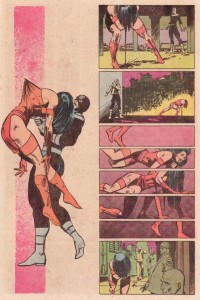
~taken from the Wiki page~
Seduction of the Innocent cited overt or covert depictions of violence, sex, drug use, and other adult fare within “crime comics” — a term Wertham used to describe not only the popular gangster/murder-oriented titles of the time, but superhero and horror comics as well. The book asserted, largely based on undocumented anecdotes, that reading this material encouraged similar behavior in children.
Comics, especially the crime/horror titles pioneered by EC, were not lacking in gruesome images; Wertham reproduced these extensively, pointing out what he saw as recurring morbid themes such as “injury to the eye”.Many of his other conjectures, particularly about hidden sexual themes (e.g. images of female nudity concealed in drawings or Batman and Robin as gay partners), met with derision within the comics industry. Wertham’s claim that Wonder Woman had a bondage subtext was somewhat better documented, as her creator William Moulton Marston had admitted as much;however, Wertham also claimed Wonder Woman’s strength and independence made her a lesbian. Wertham also claimed that Superman was both un-American and a fascist.

First U.K. printing, 1954.
Wertham critiqued the commercial environment of comic book publishing and retailing, objecting to air rifles and knives advertised alongside violent stories. Wertham sympathized with retailers who did not want to sell horror comics, yet were compelled to by their distributors’ table d’hôte product line policies.
Seduction of the Innocent was illustrated with comic-book panels offered as evidence, each accompanied by a line of Wertham’s sardonic commentary. The first printing contained a bibliography listing the comic book publishers cited, but fears of lawsuits compelled the publisher to tear the bibliography page from any copies available, so copies with an intact bibliography are rare. Early complete editions of Seduction of the Innocent often sell for high figures among book and comic book collectors.
It is worth noting that, prior to its publication, Wertham was not an anti-comic crusader, nor did he likely mean for the book to generate the public reaction it did. In Seduction of the Innocent, he puts forth several arguable progressive positions that are sometimes lost in his ‘boogeyman’-like depiction, e.g. by Scott McCloud in Reinventing Comics. For example, Wertham expressed a concern for the impact of impossibly proportioned female characters on girl readers or on the advertisements of violent and harmful toys. Primarily, Wertham assigned the blame to parents, not the industry nor the creators, in his book, and even his anxiety over Batman’s and Robin’s perceived homosexual subtexts was aimed at the welfare of a child introduced to that sort of family unit, not on some a priori immorality or sinfulness to such a lifestyle.Will Brooker also points out in Batman Unmasked: Analyzing a Cultural Icon that Wertham’s notorious reading of Batman and Robin as a homosexual couple was not of his own invention, but was suggested to him by homosexual males whom he interviewed.
Influence
The fame of Seduction of the Innocent added to Wertham’s previous celebrity as an expert witness and made him an obvious choice to appear before the Senate Subcommittee on Juvenile Delinquency led by anti-crime crusader Estes Kefauver. In extensive testimony before the committee, Wertham restated arguments from his book and pointed to comics as a major cause of juvenile crime. The committee’s questioning of their next witness, EC publisher William Gaines, focused on violent scenes of the type Wertham had decried. Though the committee’s final report did not blame comics for crime, it recommended that the comics industry tone down its content voluntarily. Possibly taking this as a veiled threat of potential censorship, publishers developed the Comics Code Authority to censor their own content. The new code not only banned violent images, but entire words and concepts (e.g. “terror” and “zombies”), and dictated that criminals must always be punished. This destroyed most EC-style titles, leaving a sanitized subset of superhero comics as the chief remaining genre. Wertham nevertheless considered the Comics Code inadequate to protect youth.
Among comic-book collectors any comic book with a story or panel referred to in Seduction of the Innocent is known as a “Seduction issue”, and is usually more valued than other issues in the same run of a title. Seduction of the Innocent is one of the few non-illustrative works to be listed in the Overstreet Comic Book Price Guide as a collectible in its own right.





